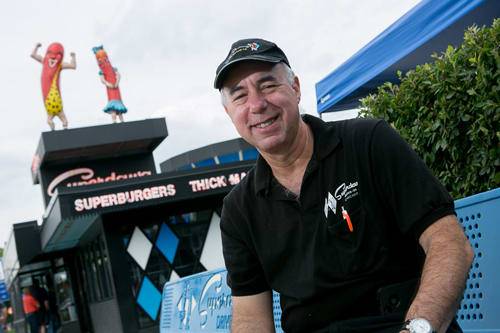Drive-In Diners Motor into 21st Century

&&&&&EMBEDDED_ELEMENT_START&&&&& {“id”:1420668710376,”originalName”:”2015_03_04_17_08_13_229_http___blogs_cars_com__a_6a00d83451b3c669e20192aca44ecb970d_800wi”,”name”:”MMS ID 58112 (created by CM Utility)”,”URI”:”/10/-2067393657-1425510493910.”,”createDate”:”2015-03-04 05:08:13″,”metadata”:{“AUTHOR”:”automatic-content-migration”,”KEYWORDS”:””},”href”:”https://www.cstatic-images.com/stock/1170×1170/10/-2067393657-1425510493910.”,”description”:”Came from http://blogs.cars.com/.a/6a00d83451b3c669e20192aca44ecb970d-800wi”,”externalid”:”58112″,”updatedby”:”cmuadmin”,”updateddate”:1425511673774,”associations”:{}} &&&&&EMBEDDED_ELEMENT_END&&&&&
As baby boomers, my husband and I have fond childhood memories of family road trips that included stops at drive-in diners that dotted the nation’s byways in the ’50s and ’60s. So we were delighted to discover Red’s Root Beer during a recent vacation near Paw Paw, Mich.
A by-product of the nation’s love affair with cars, drive-in diners surfaced in the 1920s, survived the Great Depression and thrived afterward because of their “good cheap food and fun,” writes artist Don Sawyer, who captures this slice of Americana on canvas, on dinerdon.com.
The popularity of drive-in diners peaked in the 1930s and ’40s, falling victim to the rise of fast-food giants in the 1960s and ’70s. Like drive-in movie theaters, drive-in diners seemed to be headed down the road to extinction.
However, the once-ubiquitous drive-in diner may be poised to pull a U-turn thanks to TV shows like the Food Network’s “Drive-ins, Diners and Dives” and the Travel Channel’s “Man v. Food,” and chains like Sonic Drive-In, Ruby’s Diner and A&W.
&&&&&EMBEDDED_ELEMENT_START&&&&& {“id”:1420668702549,”originalName”:”2015_03_04_17_07_42_568_http___blogs_cars_com__a_6a00d83451b3c669e201901ee4fe73970b_800wi”,”name”:”MMS ID 57288 (created by CM Utility)”,”URI”:”/86/870342903-1425510462786.”,”createDate”:”2015-03-04 05:07:42″,”metadata”:{“AUTHOR”:”automatic-content-migration”,”KEYWORDS”:””},”href”:”https://www.cstatic-images.com/stock/1170×1170/86/870342903-1425510462786.”,”description”:”Came from http://blogs.cars.com/.a/6a00d83451b3c669e201901ee4fe73970b-800wi”,”externalid”:”57288″,”updatedby”:”cmuadmin”,”updateddate”:1425511630612,”associations”:{}} &&&&&EMBEDDED_ELEMENT_END&&&&&
Sonic — which got its start in Shawnee, Okla., as the Top Hat Drive-in in 1953 — is perhaps the most visible evidence of the drive-in diner’s staying power. Today it lays claim to more than 3,500 drive-ins spread across the U.S. Customers use curbside speakers to place their orders, which are delivered by carhops (in some locations they do so on roller skates); it’s this concept that gave birth to the Top Hat’s slogan, “Service with the Speed of Sound,” and name change to Sonic in 1959. Ruby’s Diner, which also features skating carhops at some restaurants, opened in California in 1980 and now has locations in six states.
But it’s the independently owned drive-ins — like Superdawg in Chicago (pictured), Red’s Root Beer in Michigan, Mel’s Drive-in in California (“American Graffiti” was filmed at the original San Francisco location) and the Parkette in Lexington, Ky. — that steal our hearts.
Superdawg has been a Chicago mainstay since it opened in 1948; it still operates in its original city location and is owned by the same family, which opened a second location in suburban Wheeling in 2010. Both restaurants are topped by two 12-foot-tall flirtatious hot dogs representing founders Maurie and Flaurie Berman.

Drucker credits Superdawg’s longevity to providing a good product — its signature sandwich is the Superdawg, consisting of the family-recipe hot dog accompanied by fresh-cut crinkle fries — and being open year-round (each location houses a small dining room).
“People always say to us, ‘It’s such a throwback; it’s such nostalgia,’ ” he laughed. “Our comment to that is, ‘We’re not really nostalgia; we’re authentic. We were here in ’48.’ “
Opened in 2010 by retired factory worker Tim “Red” Knauss and his wife, Red’s Root Beer in Paw Paw serves made-on-the-premises root beer in frosty mugs while music from the ’50s filters into vehicles from speakers in the canopy. Knauss personally greets each carload of diners and checks back to see if they’re enjoying the food; stay long enough and your conversation will be punctuated by fans honking their horns and waving as they drive by. Like many of its brethren, Red’s hosts classic car shows during warm-weather months and is closed during the coldest months.

Have a favorite drive-in diner? Share it in the comments section below.
Related
Drive-ins Dwindle But Nostalgia Is Still Strong
Road Trip Sightseeing Tips
More Pop Culture News on Cars.com

Former Assistant Managing Editor-Production Jen Burklow is a dog lover; she carts her pack of four to canine events in her 2017 Ford Expedition EL.
Featured stories




